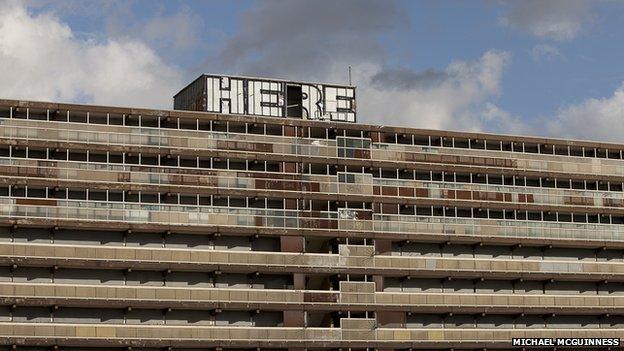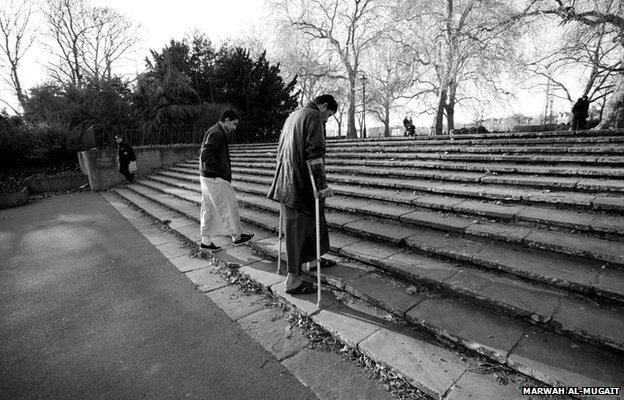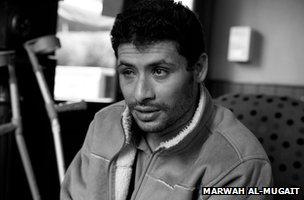Twelve weeks to produce a magazine
- Published
- comments

The year seems to be progressing at a furious pace, and so I thought it was time to catch up with Marwah Al-Mugait and Michael McGuinness, two students on the MA Photojournalism course at the University of Westminster, whose progress I've been following.
Both are now well in to the final stage of the course and have recently completed a fascinating group assignment which required them to team up and produce a magazine during the 12-week module.
The first hurdle to be crossed was for the group of photographers to agree on one direction and to ensure the final product hung together in a cohesive manner.
Each student had to take a role in the production process, suggest story ideas, shoot, write and then be led by the editorial direction of the publication. I have to say that the four magazines produced by the groups on the course are outstanding, and, as course leader Max Houghton says, they have produced work that would grace any bookstand.
Marwah and Michael were in two different groups, each shooting a story as well as aiding production and the concept.
"Making the magazine has been an incredible process. You have to work as part of a team and sometimes that is hard when things go wrong," says Michael. "But working together right from the start means you can achieve far better results, and it has been a tremendous experience. We all had to change and adapt and be open to that."
That ability to adapt and accept that your work has to fit the output is central to working as a photographer. Let's face it, we all believe we know best about how to show off our work, but sometimes we need to let go. Max Houghton agrees. "The group had some strong characters photographically who came to have one vision," he says. It has also offered the students a chance to forge partnerships and some feel they may work together in the future.
Michael's role on his team's magazine was that of production editor and it was one he came to relish as it meant he was in touch with all members of the group, helping to bring the vision together alongside the editor and picture editor.

Kay Ellis returns often to 'ghost' the now abandoned Haygate Estate where he used to live
Their magazine was called FOV, Field of View, and explores the politics of land and the environmental aspects of development. Stories range from eroding coastlines by Chiara Tomasoni and John Saint, to a look at the life of Derek Finlay, who lives on an island at the confluence of the River Brent and Grand Union Canal, also by John Saint.
Michael's piece looks at the regeneration of the Elephant and Castle area of London. Large blocks, such as the one at the top of the page, are being renovated and will eventually accommodate a mix of housing association tenants and private owners, who buy through the "right to buy" scheme. Michael's work concentrates on the lives of those who have been resettled as the work takes place, and, in his words, "mourn the loss of their old community, while looking forward to a time in the future when when they might return".
"I chose my story very early on and stuck with it," says Michael. "This meant I was very focused on the story I wanted to tell, perhaps in a different way to how it has been done before." The pictures were included in an issue of Backyard, produced at the World Photo London, external event in April.
The project has also given Michael a chance to look at the sort of work he wants to do when the course finishes. But that's the future, for now he's engaging with his challenging final project.

Marwah's group took a different approach and, rather than focusing on one theme, decided to follow a new approach and look at some of the stories in the news six to nine months ago and revisit those, but in a new way. Marwah was keen to stress that it is not about reporting on those stories again, but taking them as jumping off points to take the story forward, or in a new direction. Their magazine is called reVerb - The Second Draft of History.
"At first we struggled with the concept," says Marwah. "To make it solid was not easy and questionable, but we stuck to it, and, after lots of meetings to set the concept, we knew what we wanted."
The opening page of the magazine offers a timeline of events from the period they looked at, July to September 2011, and, alongside this, the stories in the magazine are outlined. Some follow a narrative of sorts, such as Will Berridge and Olmo Rodriguez Roces's article on Broadwater Farm, where the riots of 2011 began, through to Pio De Rose's play on Walker Evans's Beauties of the Common Tool, in which she photographs hidden cameras.
The result is fascinating and visually very powerful. It contains two major stories, one of which is Marwah's, who took the news story about the fall of Tripoli last July and decided to use that as a launching point. Marwah did some research with Will Berridge, another student in the group with whom she collaborated, and came across the fact that a number of wounded Libyan rebel fighters were being cared for in the UK, and through the embassy was able to make contact.
The soldiers were all badly wounded whilst fighting against Gaddafi and due to a lack of well equipped hospitals in Libya the government sent them to Tunisia, the UK and other European countries for treatment. Perhaps not surprisingly she was unable to obtain permission to photograph in the nursing home, so she worked with them in local parks and open spaces, each of the men offering their stories from the conflict. Some, like Ahmed, haven't seen their family for months, but, to fill the time, is learning English whilst being cared for.

Abu Abdullah discuses his time fighting the Gaddafi regime as a field commander
"I did not want to focus on their injuries and so going outside worked for us," Marwah remembers. "All of those pictured were happy with us as we built up relationships, and let them say what they wanted to say, rather than us pushing lots of questions."
The pictures are warm and perfectly suited to the story and the magazine format. It is, as Max points out, "a wonderful advert for slow journalism and good old fashioned storytelling. I'm also really pleased how they have worked on their writing skills and seen the importance of it."
Indeed, I've said it many times but any pitch to a magazine or website such as this needs a cohesive story to bind the pictures - great photographs alone do not do that.
Both of these magazines are enjoyable and informative, so why not take a look: reVerb magazine, external and FOV magazine, external.
Previous posts looking at Marwah and Michael's work: